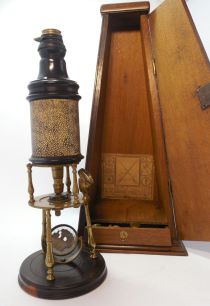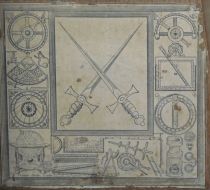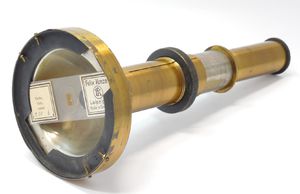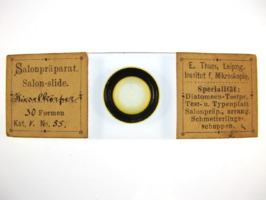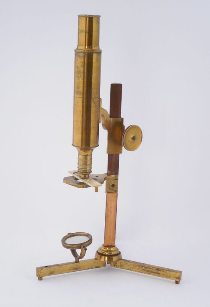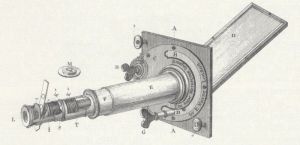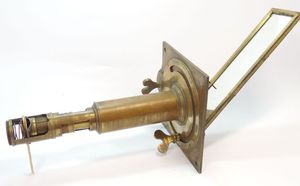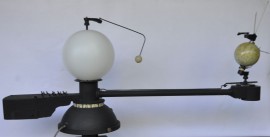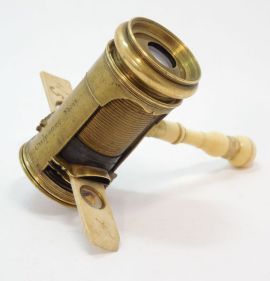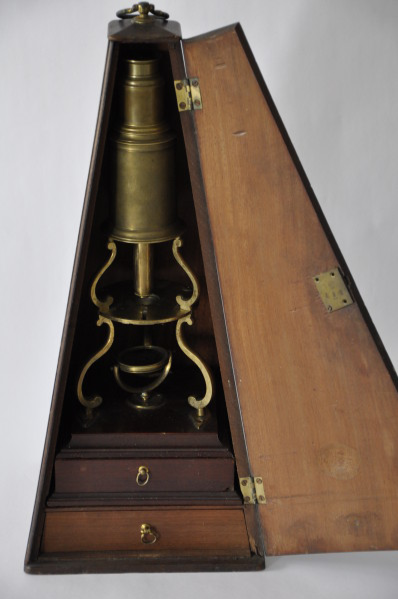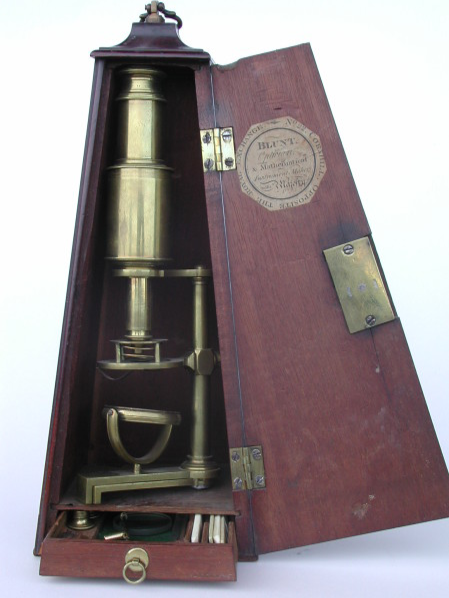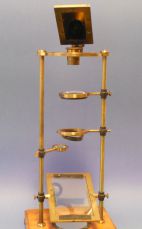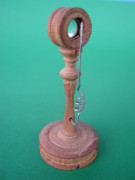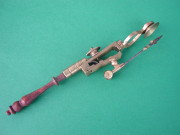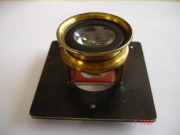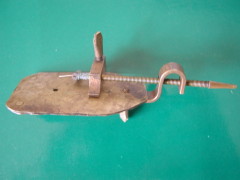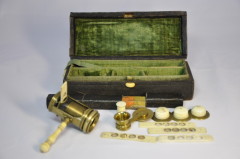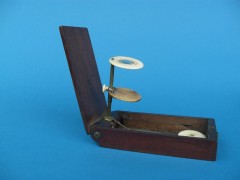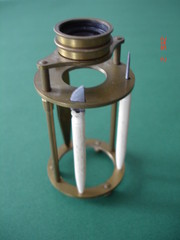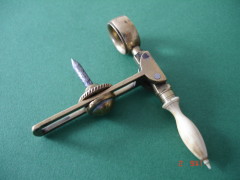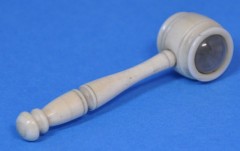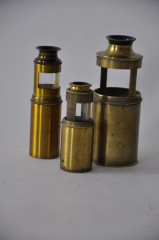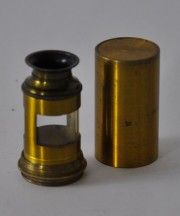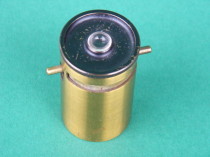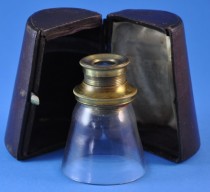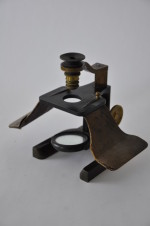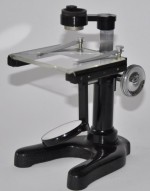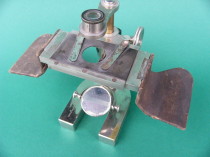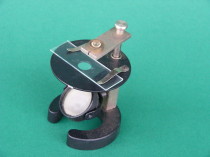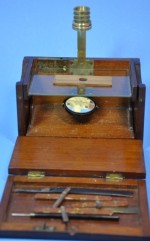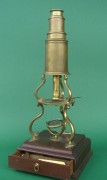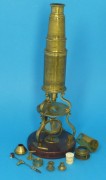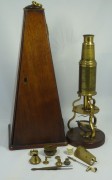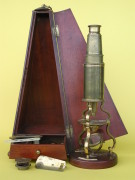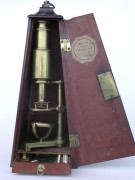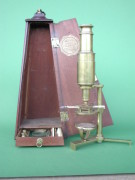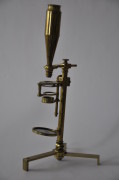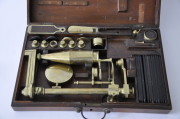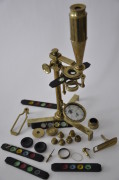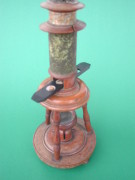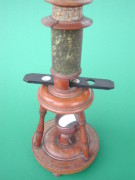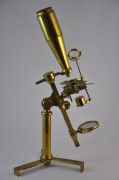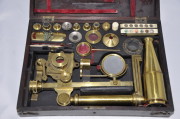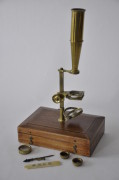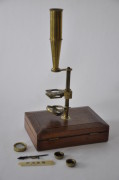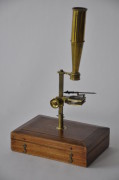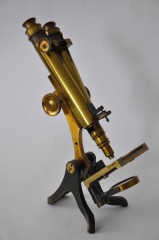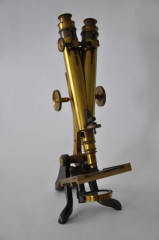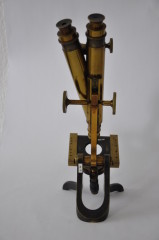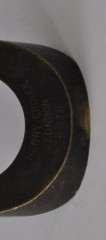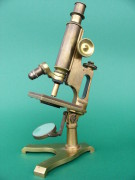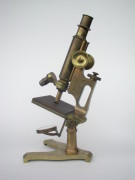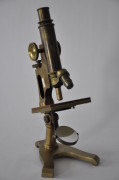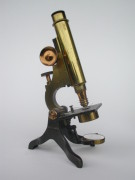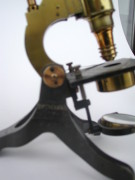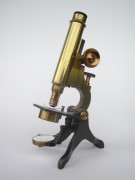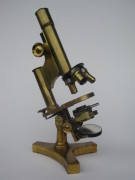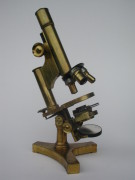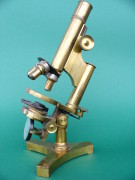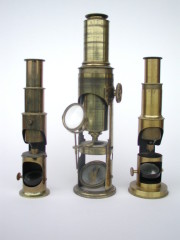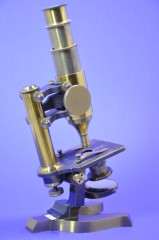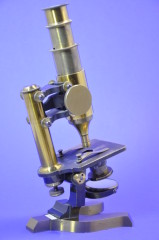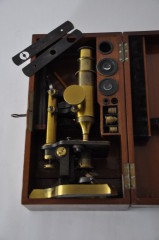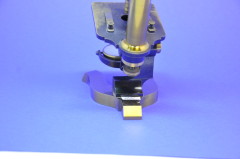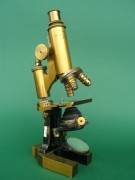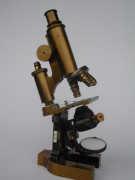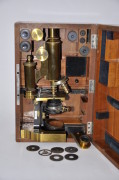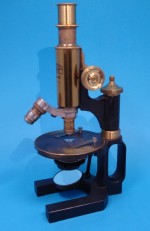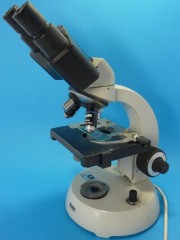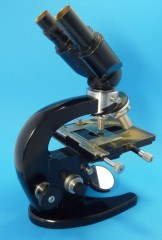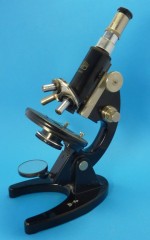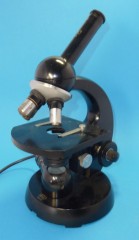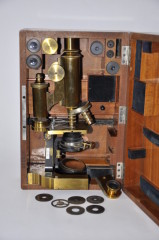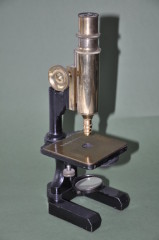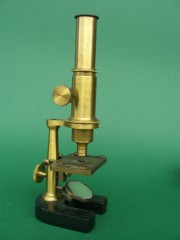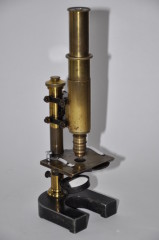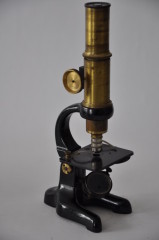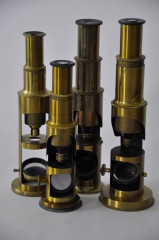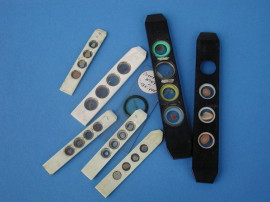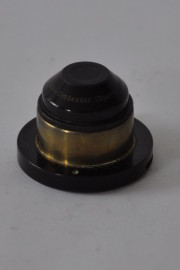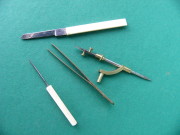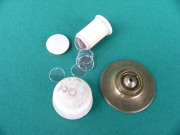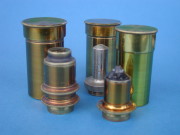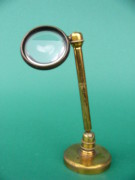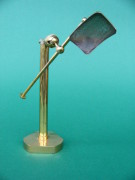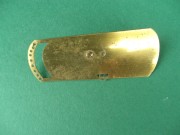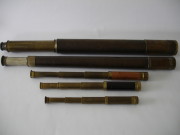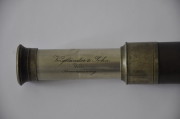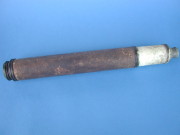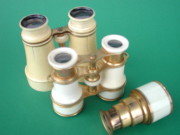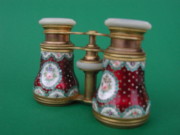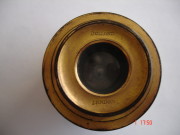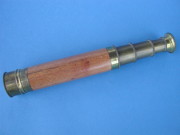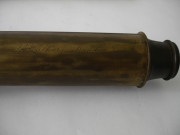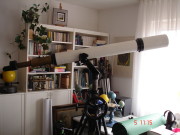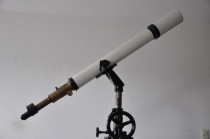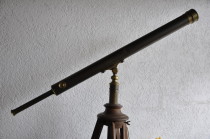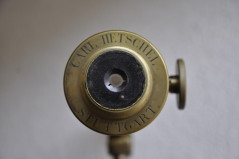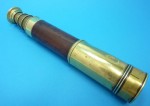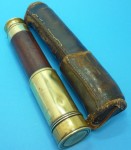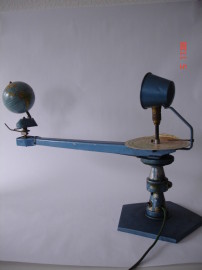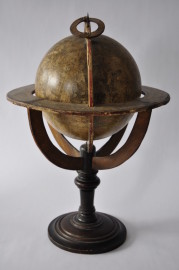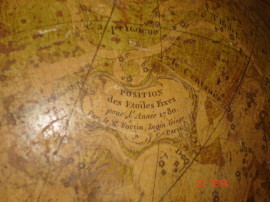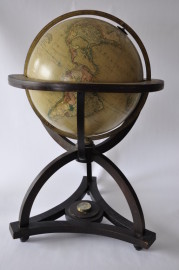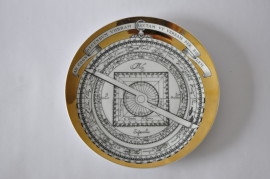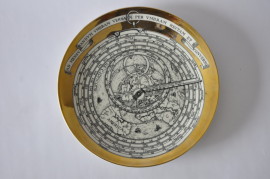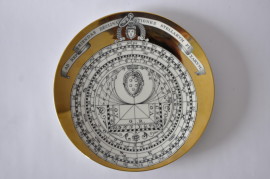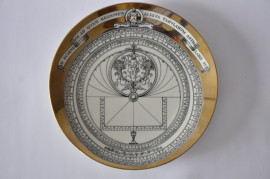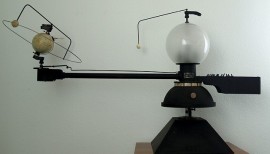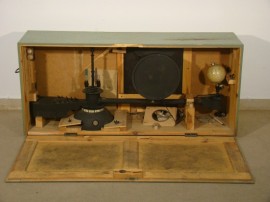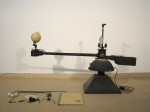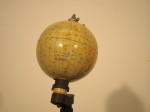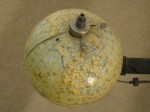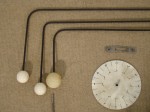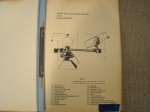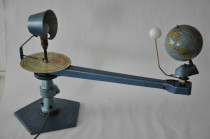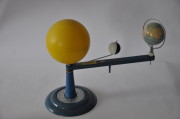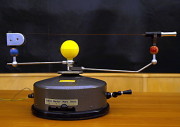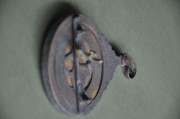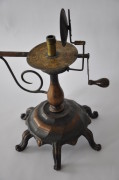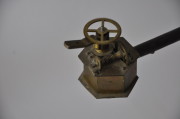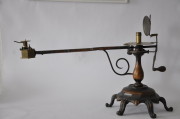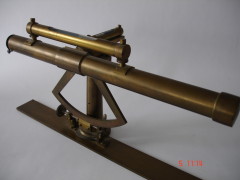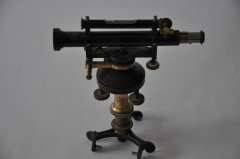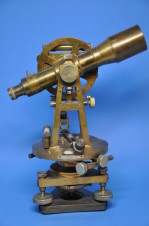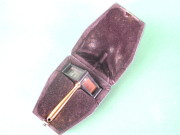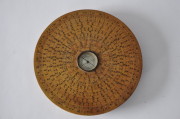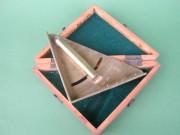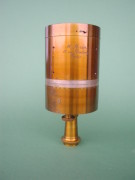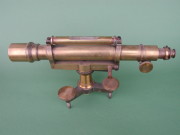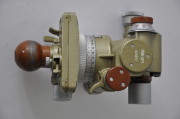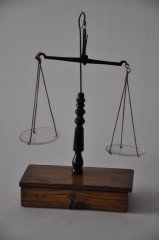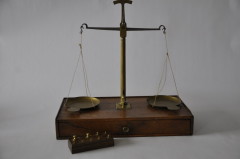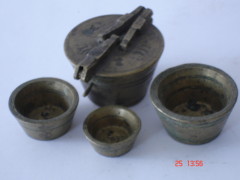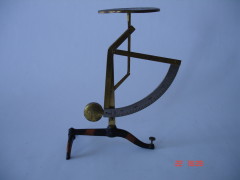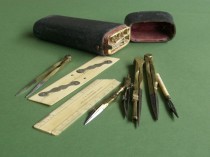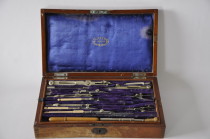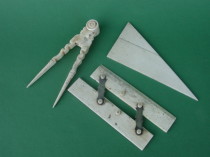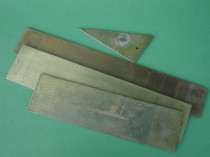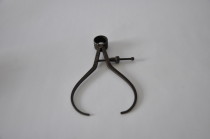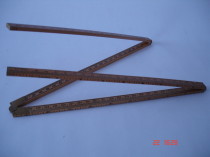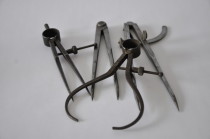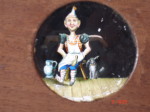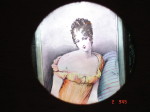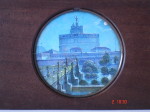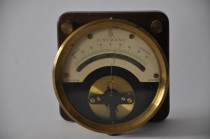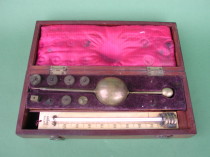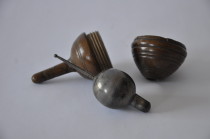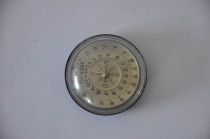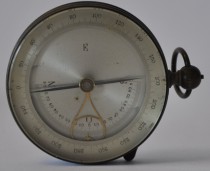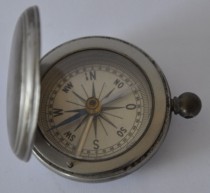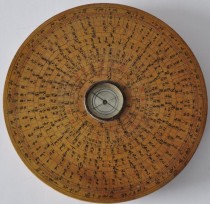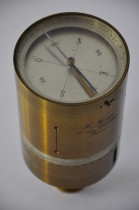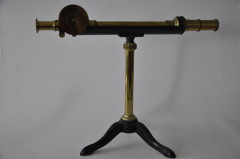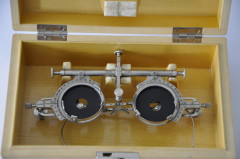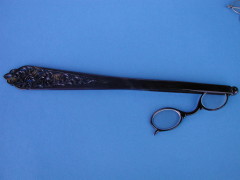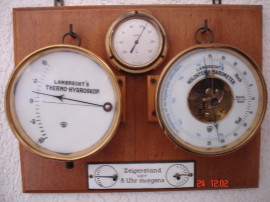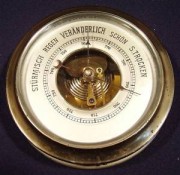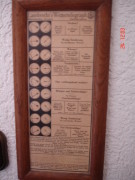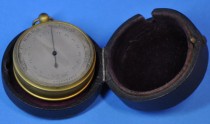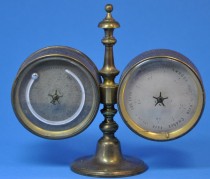Fotos
Dies ist nur ein Teil meiner Sammlung.
Weitere Instrumente gerne auf Anfrage.
This is only a part of my collection.
Please ask for more information.
If you are interested in buying an instrument, please ask for more details and prices.
Click to enlarge
Klicken Sie auf das Foto
Microscopes, Mikroskope
Simple Microscopes // einfache Mikroskope
Screw Barrel Mikroskop signiert A Shanks um 1800
Einzigartiges Screw Barrel Mikroskop ist auf einen Wurzelholz- Nussbaum Kasten montierbar. Kasten mit einem Auszug für das Mikroskop Zubehör.
Für die Durchlichtbeleuchtung ist das Mikroskop mit einem Spiegel ausgestattet.
Maße des Kastens:
Wilson Screw Barrel Mikroskop signiert Culpeper Fecit um 1720
Edmund Culpeper (1670-1738)
Screw Barrel Mikroskop in Shagreen Box( Haifisch / Rochenhaut ) mit Zubehör. Elfenbein Objektträger in Aufbewahrungskästchen, 4 Objektive mit Elfenbeinabdeckung, Auflichteinrichtung, Elfenbeindose mit Glimmerplättchen und Messingringen.
Sehr schönes Instrument funktionsfähig.
Maße:
Witherin Botanical Microscope um 1790
Dr. Edmund Withering ( 1741-1799 ) entwickelte diesen Mikrsokop Typ um 1790. Es dient vorwiegend der Untersuchung von Planzen und Insekten. Beim Öffnen des Gehäusedeckels richtet sich automatisch das Mikroskop mit dem Objekttisch und der Lupe auf. Die Fokussierung erfolgt durch Heben und Senken des Objekttisches. Die Linse des einfachen Mikroskops ist in Elfenbein gefasst.
Simple Microscope / einfaches Mikroskop / entomologisches Mikroskop um 1800
Simple Microscope / einfaches Mikroskop zur Beobachtumg von Insekten und botanischen Präparaten in Aufbewahrungshülle aus Pappe und Fischhaut ( shagreen ) Überzug. Elfenbeingriff . Mit Pinzette.
ca.1795-1800. nicht signiert
Simple botanical microscope or entomological microscope with tweezers and ivory handle with it's shagreen case. c. 1795-1800.
Botanical, entomological microscope c. 1800
Einfaches Mikroskop zur Untersuchung von Insekten und anderen Kleintieren.
Lupe in Messing gefasst. Das Objekt wird auf eine Nadel aufgespiesst und auf der Achse fokussiert.
Schönes kleines Instrument, Elfenbeingriff, nicht signiert
Raspail Type Insectoscope um 1860
Microscope a graines
Jean Francois Raspail ( 1794-1878) French Scientist and Political Reformer.
Das Insekt wird in den Glastubus eingebracht und kann durch die Lupe im Messingzylinder betrachtet werden. Der Zylinder hat ein Schraubgewinde.
Höhe ca. 5 cm
Dissecting Microscopes / Präparier Mikroskope / Microscope dissection
Dissecting Microscope, Simple Microscope in a wooden box. Not signed. Mid 19th century.
Präparier Mikroskop in einer Hoz Box. Die Seitenteile sind ausziehbar um einen besserung Zugang zu haben.
Das einfache Mikroskop kann in der Höhe gegenüber dem Arbeitstisch ( Glasplatte) in der Höhe verstellt werden. Ein Beleuchtungsspiegel befindet sich innerhalb der Box.
Präparier- Werkzeuge sind in der ausklappbaren Front untergebracht
Sehr seltenes und ausgefallenes Instrument.
Label von der Universität Liverpool im Kasten
Compound Microscopes // Zusammengesetzte Mikroskope
Culpeper Type Microscope, signed Dollond c. 1800
Culpeper Type Microscope signed Dollond London c. 1800
in Mahogany Pyramidal Case.
This brass instrument stands on a box base with a concave mirror mounted on its centre. Three scrolled legs support the circular sttage and body. The stage has a keyhole slot and a pinhole for accessories. The body consists of a draw tube that pushes into a cylinder fixed to the legs. The nose has an internal thread for objectives.
Accessories: fish plate; life box; brass box; glass slides.; ivory slides, 5 objectives; Lieberkuhn mirror; stage foreceps.
The case has a second drawer with lots of glass slides
Culpeper Type Microscope not signed c. 1800
CulpeperType Microscope not signed c. 18oo
This brass instrument stands on a round wooden base
Pyramidal wooden case with a single drawer
Accessories: stage forceps; fisplate; spring stage; brass slider, tweezers, 3 objectives; conical aperture
Compound Microscope signed Blunt c. 1795
Compound Microscope by Thomas Blunt c. 1810
Blunt Optician & Mathematical Instrument Maker to Her Majesty No. 22; Opposite the Royal Exchange, Cornhill
Brass Microscope with folding Tripod. Mirror removable from the foot
The tube has an eyecup, with a sliding dust cover, that screws over the eye lens, and a field lens. The nose has an internal thread for objectives. Trademark with Blunt logo. in the case. Lock but no key.
Thomas Blunt (c1746–1822) apprenticed c1760 to Edward Nairne (1726–1806), and became his partner in 1774. Nairne introduced the Chest Microscope with the manufacture of a Cuff-style instrument mounted on a tilting support attached to an elaborate mahogany box. Nairne continued to make instruments of this style at 22 Cornhill,Londonwell after Blunt joined the firm. Known Nairne instruments were Cuff-style, thus given the Gould body and rotating objective system and the Blunt & Son trade card, it is possible that this particular instrument was created after Nairne died. 1793 Blunt opened his own business up to 1802. His son become partner until 1822.
Most Improved Type Microscope not signed c. 1830
Engl. Compound Microscope c. 1800 not signed
Most Improved Type
This Microscope has a folding tripod base to which is attached a circular pillar surmounted by a compass joint. A short arm with rack and pinion adjustment, attached to the pillar carries a limb with the stage. The stage has projections for forceps and spring clips. There is also a Martin superstage and a disc.
A condenser is also on the sleeve and has an adjustable angle arm.
The body tube has a 1-3/4 screw-inch screw in the conical nose, and screws to the arm. One screw –in eyepiece has three lenses, and there is a field lens. No drawtube.
The mirror is attached to the pillar
Very nice Mahogany case; 6 objectives, fish plate, oval glass, life box, brass box, pin, 8 wooden slides, etc.
Nuremberg Toy Microscope signed IM c.1800
Nuremberg Toy Microscope c.1800 signed IM
This three-pillared microscope was made in or around the town of Nuremberg, Germanyby the toy-makers of the area. These craftsmen were, and still are, famous for their wooden toys. Nuremberg microscopes all are constructed with a main body consisting of two draw-tubes made of cardboard with lathe-turned wood trim. This microscope body is inserted into a third tube, which is supported by three turned pillars on a wooden base. Focusing is achieved by sliding the microscope body inside the supportive cardboard tube. The sample remains fixed by a spring stage and is illuminated from below by the substage mirror. In addition, the top tube (holding the eyepiece and field lenses) slides inside the base tube (which holds the objective lens). The optics consist of only three lenses: the eyepiece, field, and objective lens. Samples were mounted in the wooden sample holder and held in place by the Bonanni spring stage. The illuminating mirror is single-sided and mounted on a rotating wooden base. The microscope optical body is 15–18cm long, and the total height of this instrument is appx 32cm.
All Nuremberg microscopes have some degree of decoration. This microscope has shagreen covering the support base, and printed paper covering the body tube. This popular style, the shagreen-covered, tripod design, was modeled after the more elegant microscopes by Culpeper of the early part of the 18th century. OtherNuremberg microscopes are characterized by having a rectangular drum stand or a side pillar design.
Many of these instruments have initials burnt into the wood base, some surrounded by a circle, some by a heart shape.
This Microscope is missing one tube and the eyepiece.
Most Improved Microscope signed Tuther c. 1830
Most Improved Type Compound Microscope signed by John Tuther c. 1820
Very rare brass microscope in its original case.
Accessories: Fishplate, Lieberkuhn, Stage foreceps, Condesor lens, Stage magnifier, ivory slides, talc box.
Einfaches und Zusammengesetztes Mikroskop "Most Improved Type"
signiert: Tuther London
Im Mahagonikasten mit kompletten Tubehör wie Fischplatte, Lieberkühn Objektiv, Lupe, Kondensor , Elfenbein Präparate etc. Sehr schönes Instrument um 1820
Gould Style Microscope c. 1830 / Engl. Reisemikroskop nicht signiert um 1830
Gould/ Cary Type Simple and Compound Microscope c. 1830 not signed
This Cary/Gould-type brass compound microscope has a pillar with a rectangular cross section that screws into a socket on the wooden case lid. The body tube screws into an arm attached to the top of the pillar. The tube has a cylindrical-shaped upper half and a conical-shaped lower half. The three objective lenses, each with a different magnification, can be used with the main body as a compound microscope, or they can be screwed into the arm themselves for use as a low-power simple microscope. In either mode, they can be used separately, or screwed together for greater magnification. The three lens eyepiece tube slides into the top of the body tube and can be partially withdrawn to increase magnification. It is focused with a rack and pinion that moves the stage up and down on the pillar. The concave mirror is mounted on the pillar with a pin. The microscope disassembles to fit in its mahogany case and was designed to be small and portable for use in the field.
Accessories: Bone slides, Life box, Magnifier, stage forceps etc.
Gould Style Simple and Compound Type Microscope c.1830
Gould / Cary Simple and Commpound Microscope c. 1830 not signed
similar to the one before
This Cary/Gould-type brass compound microscope has a pillar with a rectangular cross section that screws into a socket on the wooden case lid. The body tube screws into an arm attached to the top of the pillar. The tube has a cylindrical-shaped upper half and a conical-shaped lower nedhalf. The three objective lenses, each with a different magnification, can be used with the main body as a compound microscope, or they can be screwed into the arm themselves for use as a low-power simple microscope. In either mode, they can be used separately, or screwed together for greater magnification. The three lens eyepiece tube slides into the top of the body tube and can be partially withdrawn to increase magnification. It is focused with a rack and pinion that moves the stage up and down on the pillar. The concave mirror is mounted on the pillar with a pin. The microscope disassembles to fit in its mahogany case and was designed to be small and portable for use in the field.
Gould Type Microscope not signed
Cary Type Microscope not signed c. 1820
The microscope is a Cary -style brass compound microscope with cylindrical body tube and standard three-lens optics. The rectangular pillar, which mounts on hinge of its own wood box, has a rack & pinion focus. There is no fine focus. The microscope body screws into a brass arm that press- fits into a rotating bracket at the top of the pillar (this allows the microscope to rotate away from the case). The mirror has two reflecting sides, one plane and the other parabolic. The top case must be removed to use the microscope in transmitted light mode in order for the lamp to be positioned correctly.
Accessories include bone specimen slides, life box, stage forceps etc.
Englische Mikroskope / English Microscopes
Binocular Microscope by Henry Crouch London No. 4376 c. 1870
This Binocular has an english foot. The binocular tubes have a transverse adjustment bar for coarse adjustment of the drawtubes. The nose has a thread for the objective.. The curved limb has a rack and pinion coarse adjustment and the fine adjustment is a short lever screw in front of the tubes. The stage is squared.
Compound Microscope by J. Lizars No 206
Compound Monocular Microscope by J. Lizars in Glasgow. Y-sahped foot with joint connection. Carrying handle ( jug handle) Coarse adjustment by rack and pinion focus. Fine adjustment by screw on top of the handle. Double nosepiece.
Compound Microscope by Johnson & Sons London No. Comet 837 ca. 1890
Brass Microscope with english shaped foot. Tubular pillar. Beneath the circular stage is a tube for the cylinder condensor. Coarse focus by rack and pinion, fine adjustment by micrometer.
Single nose piece
Compound Microscope by R & J Beck no 19110
Brass Microscope with y-shaped foot. triple nosepiece with three objectives. Coarse adjustment by rack and pinion. Fine adjustment by a lever screw.
Martin Type Microscope not signed c. 1870
Martin Type microscope with six numbered objectives in a mahogany case and lot of accessories. There is a two element eyepiece in a draw tube.
Drum Type Microscopes / Trommelmikroskope
Compound Microscope Seibert ca. 1880
Compound Microscope by Reichert Wien
Microscope Carl Zeiss Stativ VA
Zeiss Labormikroskop; Stativ VA ohne Kippe von 1910. Zaponiertes Messing, und lackiertes Gußeisen. Stativ mit integriertem Griff unter der Tischplatte. Dreh- und schwenkbarer Plan- und Konkavspiegel, Fokus über seitlichen Trieb, Feineinstellung durch Rändelrad an der Säule
Seriennummer 57423
Inventarnummer. A.I.W 122 ( Anatomisches Institut Würzburg ?)
Mikroskope von Carl Zeiss / Carl Zeiss Microscopes
Various Microscopes
Accessories
Nautische Instrumente, Marine,
Telescopes / Binoculars / Opera Glasses
Large Carl Zeiss Azimuthal Telescope Nr.12353 on Stand. Laquered brass and cast iron. Fitted in the original wooden case. Height ca. 18000 mm
ca. 1925-1930
Optical Dia 80 mm
Length: Tube 1200 mm
Großes Carl Zeiss Azimuthal Fernrohr Nr. 12353 auf Metall Feld Stativ.
Messing zaponiert, Eisen lackiert.
Optik: 80 / 1200 mm
Standhöhe ca. 1800 mm
Sold / Verkauft

